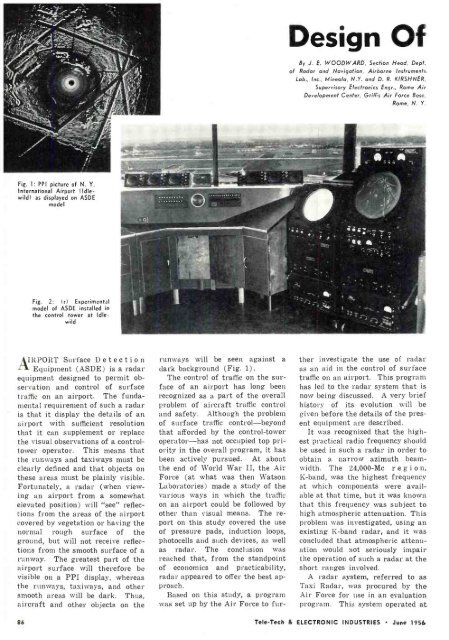TELE-TECH & - AmericanRadioHistory.Com
TELE-TECH & - AmericanRadioHistory.Com
TELE-TECH & - AmericanRadioHistory.Com
You also want an ePaper? Increase the reach of your titles
YUMPU automatically turns print PDFs into web optimized ePapers that Google loves.
Design Of<br />
By J. E. WOODWARD, Section Head, Dept.<br />
of Radar and Navigation, Airborne Instruments<br />
Lab., Inc., Mineola, N.Y. and D. R. KIRSHNER,<br />
Supervisory Electronics Engr., Rome Air<br />
Development Center, Griffis Air Force Base,<br />
Rome, N. Y.<br />
Fig. 1: PPI picture of N. Y.<br />
International Airport (Idlewild)<br />
as displayed on ASDE<br />
model<br />
Fig. 2: Irl Experimental<br />
model of ASDE installed in<br />
the control tower at Idle -<br />
wild<br />
AIRPORT Surface Detection<br />
Equipment (ASDE) is a radar<br />
equipment designed to permit ob-<br />
servation and control of surface<br />
traffic on an airport. The fundamental<br />
requirement of such a radar<br />
is that it display the details of an<br />
airport with sufficient resolution<br />
that it can supplement or replace<br />
the visual observations of a control -<br />
tower operator. This means that<br />
the runways and taxiways must be<br />
clearly defined and that objects on<br />
these areas must be plainly visible.<br />
Fortunately, a radar (when viewing<br />
an airport from a somewhat<br />
elevated position) will "see" reflections<br />
from the areas of the airport<br />
covered by vegetation or having the<br />
normal rough surface of the<br />
ground, but will not receive reflections<br />
from the smooth surface of a<br />
runway. The greatest part of the<br />
airport surface will therefore be<br />
visible on a PPI display, whereas<br />
the runways, taxiways, and other<br />
smooth areas will be dark. Thus,<br />
aircraft and other objects on the<br />
runways will be seen against a<br />
dark background (Fig. 1).<br />
The control of traffic on the surface<br />
of an airport has long been<br />
recognized as a part of the overall<br />
problem of aircraft traffic control<br />
and safety. Although the problem<br />
of surface traffic control- beyond<br />
that afforded by the control -tower<br />
operator -has not occupied top pri-<br />
ority in the overall program, it has<br />
been actively pursued. At about<br />
the end of World War II, the Air<br />
Force (at what was then Watson<br />
Laboratories) made a study of the<br />
various ways in which the traffic<br />
on an airport could be followed by<br />
other than visual means. The report<br />
on this study covered the use<br />
of pressure pads, induction loops,<br />
photocells and such devices, as well<br />
as radar. The conclusion was<br />
reached that, from the standpoint<br />
of economics and practicability,<br />
radar appeared to offer the best approach.<br />
Based on this study, a program<br />
was set up by the Air Force to fur-<br />
ther investigate the use of radar<br />
as an aid in the control of surface<br />
traffic on an airport. This program<br />
has led to the radar system that is<br />
now being discussed. A very brief<br />
history of its evolution will be<br />
given before the details of the present<br />
equipment are described.<br />
It was recognized that the highest<br />
practical radio frequency should<br />
be used in such a radar in order to<br />
obtain a narrow azimuth beam -<br />
width. The 24,000 -Mc r e g i o n,<br />
K -band, was the highest frequency<br />
at which components were available<br />
at that time, but it was known<br />
that this frequency was subject to<br />
high atmospheric attenuation. This<br />
problem was investigated, using an<br />
existing K -band radar, and it was<br />
concluded that atmospheric attenuation<br />
would not seriously impair<br />
the operation of such a radar at the<br />
short ranges involved.<br />
A radar system, referred to as<br />
Taxi Radar, was procured by the<br />
Air Force for use in an evaluation<br />
program. This system operated at<br />
86 Tele -Tech & ELECTRONIC INDUSTRIES June 1956
















